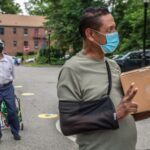Deemed by the federal government as “essential” to the country, immigrant field and dairy workers were told to keep working despite statewide stay-at-home directives in New York State. Undocumented workers that might choose not to comply would risk the loss of employment (with no access to unemployment benefits due to their immigration status) and eviction from employer provided housing. Due to the nature of working and living conditions on farms, social distancing among farmworkers is nearly impossible and farmworkers were not provided with Personal Protective Equipment (PPE) until infections were at an alarmingly high rate in NYS. Once infected, farmworkers were directed to contact County Health Departments that were frequently unfamiliar with the farmworker population and often lacked the necessary language or cultural competency skills to provide services to that community. Local community members expressed opinions that immigrant farmworkers were transmitters of the virus contributing to high levels of fear and mistrust in rural communities. Trusted organizations such as the Cornell Farmworker Program (CFP) mobilized to provide information, PPE, and other needed supports during the coronavirus pandemic. To support these efforts, the Cornell Farmworker Program transitioned from face-to-face interactions to large-scale two-way communications through cell phones and text messages and partnered with Finger Lakes Community Health, a federally designated migrant farmworker health provider to bridge the gaps in rural health provision to farmworkers.
Using culturally appropriate, trauma-informed support to promote bicultural self-efficacy among resettled refugees: A conceptual model
Resettled refugees face pressure to integrate successfully into the culture of their resettlement country within a relatively short period of time. Though successful integration is important, research has shown that ethnic identity and participation in the ethnic culture of origin play a key role in supporting the mental health of resettled refugees. This paper presents…

